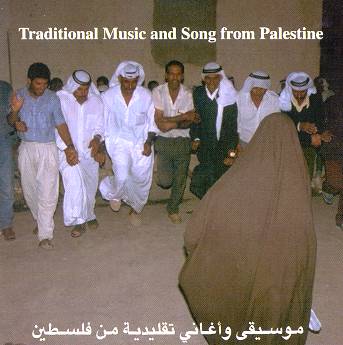The Popular Art Center (PAC) launched the Traditional
Music and Song Research Project in the mid 1990s in an
attempt to build a National Archive for the research and
preservation of Palestinian folklore. With the help of
the Welfare Association in Geneva, Switzerland and
Buntstift Foundation, in Goettingen, Germany, the Center
was able to collect and document many aspects of
Palestinian life including information about traditional
musicians, singers, songs, genres, instruments, rhythms,
lyrics, melodies, and regional melodic variations as well
as conducting more general reserach into the function of
music in Palestinian society. The Center recorded
hundreds of hours of live and/or staged performances
mainly in the northern and central regions of the West
Bank. The Center released this CD in 1997 as a first step
towards introducing this music to the rest of the world.
Thereafter, the Center has continued its collection of
musical material and has expanded the regions that have
so far been investigated.
Many aspects of Palestinian folk music are presented in the CD: instrumental dance songs and/or pieces, improvisations, short songs and long songs. The CD highlights instrumental and vocal virtuosity and interpretations, in addition to regional melodic variations. The 13 tracks offer a reasonable overview of Palestinian folk music, albeit with some bias towards the northern regions. The notes provide tips about the history of the music, its origins, function in society, and the changes it underwent over the years. They also provide descriptions of the recorded instruments, playing methods, and the actual materials the instruments are crafted from.
My main criticism, however, concerns the notes, which appear to lack expert input. Not enough information is provided about the settings in which these particular pieces were performed, for example, nor is there any information about the vocal repertoire, poetry, vocal and instrumental improvisations. Introduced in the CD, for instance, is Musa al-`Hāfidh, (tracks 8, 11, 12 and 13), who is considered one of the best Zajal poets of his generation. Zajal, which is a form of poetry, common in the Levant area, is composed and sung in the colloquial Palestinian, Lebanese and Syrian dialects of Arabic. The zajal poet is traditionally expected to improvise his own poetry and perform it in song at festivals and festive occasions (tracks 8, 11), often for long hours, when representing his village or community. Currently in his late forties, al-Hafidh attributes his knowledge and mastery of Zajal and Zajal techniques to his own father, a Zajal master, whom had tutored the young Musa early on. So far, al-Hafidh has published two works on Zajal entitled `Hadīth Qarāya, and al-Zajal al-Shabi. In these books, he introduces some of the subgenres of Zajal such as: Atāba (track 13), Murābba, Muthamman, Muanna, Qurrādi, and discusses their melodic and structural designs, poetic meters, in addition to rhyme schemes.
His books also include some examples of
each genre and explanations of their poetic-musical
compositional techniques and some common variations on
them. Other performers were also introduced in the CD
including Majid abu-Jarār in tracks 1, 10 on mijwiz
( a cane double-bore shawm), and vocal in track 9; Awa
abu-`Hadid in tracks 3 and 4 on shibbabah (an end-blown
flute) and rababah (a bowed lute); and Atif Swaitāt
in track 2 on yarghul (similar to the mijwiz,
but with drone rather than double pipe). Information
about the dialects and regional variations on melody and
lyrics is equally lacking. Issa Boulos
|
